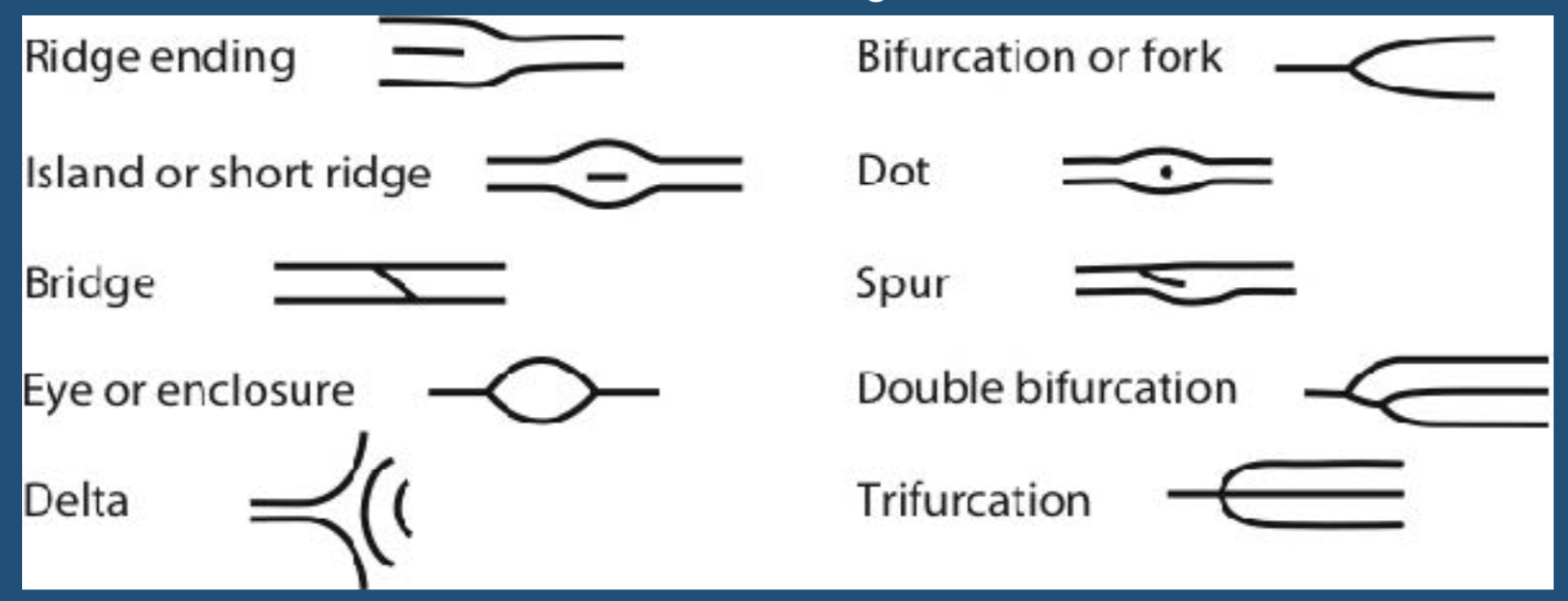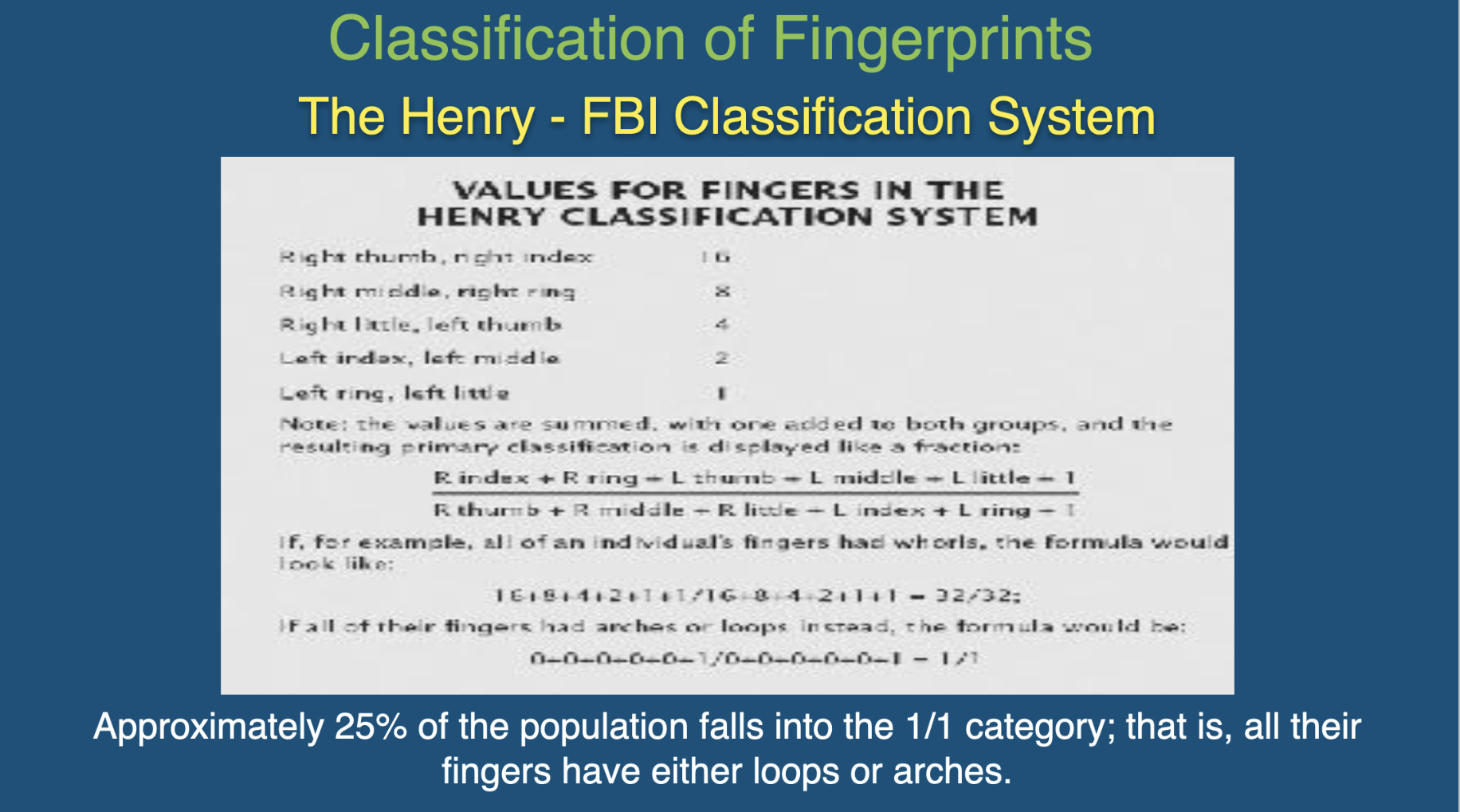Lecture 11: fingerprints and other impressions
Sir William J. Herschelco
llected the first fingerprint in 1858 from India
Dr. Henry Faulds
published first paper on fingerprinting in Nature, 1880
1/42
There's no tags or description
Looks like no tags are added yet.
Name | Mastery | Learn | Test | Matching | Spaced |
|---|
No study sessions yet.
43 Terms
Sir William J. Herschelco
llected the first fingerprint in 1858 from India
Dr. Henry Faulds
published first paper on fingerprinting in Nature, 1880
Sir Francis Galton
father of fingerprinting
Sir Edward Richard Henry
developed Henry’s fingerprint classification system in 1897
Scotland Yard adopted Henry’s system in 1901 as an official method for criminal identification
alphonse Bertillon:
anthropometry or Bertillon system in 1883
1903: anthropometry to fingerprinting
will and william west both at Ft. Leavenworth prison
very similar bertillon measurements
fingerprints identified the men
Fingerprinting in the USA
1901: first systematic and official use by NY city civil service commision
1924: FBI fingerprint repository established. FBI have largest collection of fingerprints
1990s: automated fingerproint identification systems (AFIS) begin widespread use around the country
1999: FBI started integrated AFIS (IAFIS) at clarksburg, WV
Principles of Fingerprinting
a fingerprint is unique (individualized characteristics)
fingerprints are permanent
fingerprints have general ridge patterns that can be classified (class characteristics)

A fingerprint is unique
can have multiple characteristics including:
ridge ending
island or short ridge
bridge
eye or enclosure
delta
bifurcation or fork
dot
spur
double bifurcation
trifurcation
Fingerprints are permanent
develop on fetus pre-birth (10-14 weeks)
the dermal papillae is responsible for determing the form and pattern of the ridges on the surface of the skin
general ridge patterns: L.A.W.
loops (65% of all fingerprints)
arches (5% of all fingerprints)
whorls (30% of all fingerprints)
Loop
one or more ridge enter and exit from the same side
have on delta
two types, ulnar and radial
ulnar loops
opens toward the little finger
radial loop
opens toward the thumb
type lines
2 innermost ridges which run parallel and then diverge and surrounds the pattern area
core
approx. the center of the pattern
arch
looks like a bell curve grading scale
enter on one side and ext on the other side
no delta or core
two types: plain and tented
plain arch
looks like a wave
tented arch
like plain arch, but ridges meet at angle <90 degrees.
whorl
rounded or circular shape
have minimum of two deltas and a core
four types: plain, central pocket loop, double loop, accidental
plain whorl
an imaginary line drawn between the two deltas touches any of the spiral ridges
central pocket loop whorl
an imaginary line drawn between the two deltas does not touch any of the spiral ridges
double loop whorl
made of of two loops combined into one
accidental
have two or more patterns (excluding plain arch) or no known pattern
steps to identify and individualize ridges: ACE-V process
analysis: determine distortion and value minutiae
comparison: compare the questioned print at (3) levels
a. level 1: general ridge flow and patterns, NOT sufficient for individualization, can be used for exclusion
b. Level 2: compare ridge characteristics, sufficient for individualization
c. level 3: ridge details such as pores, breaks, scars, creases etc.
evaluation: identification or exclusion or inconclusive
verification: independent examination by second examiner

The henry-FBI classification system
the system is subdivided into primary, secondary, sub-secondary, final, major, and key
the primary classification is based on the value of whorl patterns present
each finger is given a point value
a fingerprint clasification system cannot in itself unequivocally identify an individual; it will merely provide fingerprint examiner with a number of candidates, all of whom have an indistringuishable set of prints in the system’s file
AFIS/IAFIS: automated fingerprint identification system
a computer system for storing and retrieving fingerprints
began in the early 1970s to:
search large files for a set of prints taken from an individual
compare a single print, usually a latent print developed from a crime scene
by 1990s most large jurisdictions had their own system in place
Other facts about AFIS system
the problem with AFIS- a person’s fingerprints may be in one afis but not in others
1991: FBI established IAFIS which is a national database of all 10-print cards from all over the country
open for 24 hours and 365 days a year
contain /70 million criminals and 34 million civilfingerprints
response time is about 27 minutes
patent or visible prints
made when friction ridge comes into contact with colored materials such as blood, paint, ink, grease, etc.
plastic prints
ridge impression on soft materials such as soap, wax, dust, clay, etc.
latent/invisible prints
ridge impression that are produced by transfer of sweat (98-99%) and oils on a surface
visualization of latent prints method: hard/non absorbent surface, powder method
black powder made up of charcoal; good for light surface
gray powder: made up of aluminum dust; good for dark surface
magnetic powder: good for leather, rough plastics,; non-destructive
flourescent powders: flourescein (UV light)
iodine fuming for latent prints: soft or porous surface
the oldest chemical method
fumes most probably react with oils and fats
must be photographed immediately
can be stored for several months after covering with cellophane tape
ninhydrin for soft of porous surfaces
spray ninhydrin on the surface
print appear within an hour after application
ninhydrin reacts with the amino acids and produce a dark purple color
method of choice because of sensitivity and easy to use
silver nitrate/physical developer: soft porous surfaces
work even if ninhydrin fails
washes away any trance of protein
order of application: iodine-ninhydrin-physical developer
superglue fumes: non-pourous surface
98-99% cyanoacrylate ester
when heated cyanoacrylate ester band produces fumes
good for small closed areas such as car’s interior and for non-porous surface
photography and lifting
the camera is fitted with an attachment to give ~ 1:1 photo of fingerprint
an adhesive sheet is used to “lift” the powdered print off the can.
other impressions
impressions other than fingerprints and firearm and toolmarks encountered at a crime scene include, but are not limited
shoe prints
tire marks
fabric impressions
they can be left on a variiety of surfaces in a variety of scenes.
preserving impressions
the primary consideration collecting impressions at the crime scene is the preservation of the impression or its reproduction for later examination in the crime laboratory
before an impression is moved or handled, several photographs should be taken from various angles
it is preferable to use the original impression for comparison
lifting impressions
if an impression cannot be taken to the laboratory, it may be preserved in a manner similar to lifting a fingerprint
especially useful for impressions in light deposits of dust or dirt .
electrostatic lifting
a sheet of mylar film is placed over the impression
the electrode of a high-voltage electrostatic unit is attached to the mylar sheet, and the ground electrode is attached to the earth plate
the electrostatic charge applied causing the dust to transfer to the lifting film
casting impressions
class 1 dental stone is generally used for casting shoe and tire impressions
snow impression wax is an aerosol used for casting impressions in snow
chemicals can be also be used to enhance shoe impressions in blood: luminal, bromohphenol blue
comparing impressions
value of the impression is determined by the number of class and individual characteristics that the examiner finds
size, shape, or design may permit the conclusion that the impression could have exclude other possible sources from having the same class characteristics
more significant is the existence of individual characteristics arising out of wear, cuts, gougges, or other damage
a suffiient number or the uniqueness of such points of comparison supports a finding that both the evidence and test impressions originated from only one source
human bite marks on skin and foodstuffs have been important items of evidence for convicting defendants in a number of homicide and rape cases in recent years